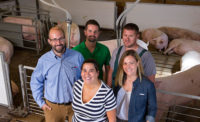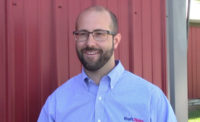Marissa Mulligan, undergraduate student at The Ohio State University, discusses her research into sow group housing interaction with electric-style feeders with The National Provisioner editor-in-chief Andy Hanacek.
Andy Hanacek: Marissa, thanks for joining me here and talking a little bit about what you at Ohio State here. You are not a farm girl, and most of the meat science, animal science students I meet have grown up on farms. Give me a little bit of background on where you are from and how you got into animal science here and animal handling.
Marissa Mulligan: I grew up in Philadelphia, Pennsylvania, and I had never handled an animal before I came to Ohio State. The biggest thing that drew me to agriculture was just that in a few years we are going to have to feed nine billion people. It is such a growing industry, and it is fascinating. I’ve always loved animals. I’ve always wanted to be a veterinarian. Then, when I came here, [I found] there are other avenues to work with animals and to feed people and really make a difference in the world. I was just so drawn to it.
Hanacek: Was it a class you took or a professor that drew you into it? How did it happen?
Mulligan: I was specifically drawn to animal welfare, because agriculture is such a huge spectrum. Animal welfare definitely felt like the place for me when I started talking to Dr. Pairis-Garcia. She came and guest lectured at one of my classes, and then I went into her office and was talking to her about the different career opportunities and research opportunities they have in animal welfare, and it sounded like such the avenue that I wanted to go in. Over the summer, I got to do a research project in Sow Group Housing, and I really found that I loved it and want to do that for the rest of my life. She has definitely been a mentor to me [while] trying to figure out what I wanted to do.
Hanacek: Talk about some of the projects you’ve gotten to work on then in your short time in animal science. What was one of the most interesting things you learned about whatever animal you were studying at the time?
Mulligan: I started in the Animal Welfare Lab doing a weaning project with lambs. There were a bunch of different weaning strategies, and we would watch video and record their behavior and look for stressors on the animals and how they were most efficient, looking at parasites and stuff like that. So that was super interesting. I really, really enjoy sheep. I would actually like to raise sheep one day or goats, but then I got really interested in sows when I was doing my research this summer looking at feeding behavior. So I was looking at an electric-style feeding apparatus in their environment and just looking at the general aggression around the feeder, the duration of time around the feeder, the frequency of time they went to the feeder, and the first time they decided to feed in the day. I related that to ranking, so what I found most interesting was that the sub-dominant sows, which are not the most aggressive and not the least aggressive, they are somewhere in between, are the ones that go into the feeder the longest. They stay the longest and go the least amount of times. So they are going, they are feeding and they are leaving. They don’t want anything to do with the aggression around the feeder. They want to completely avoid it all. That is what I noticed when I was watching the video.
Hanacek: What’s next for you? You’re a senior. When do you graduate and what from there? You can’t predict the future, but what’s your plan as of now?
Mulligan: Yes, I’m a senior, and I’ll be graduating in the spring. I would love to go get my Master’s doing research in group housing, because we are nowhere near where we need to be for Ohio to make the transition to group housing. There’s still so much a producer needs to know, and there’s so much that welfare that needs to go into it that needs to be explored. So I would love to get my Master’s in that, but my end goal… I would love to use my research and implement that on farms whether that be working for a large company and developing small research studies, implementing that on farm and making them more productive and more profitable while improving the animals welfare.
Be sure to check out all the coverage of our November cover story here.


Report Abusive Comment